Menu


Among the most highly revered functional mushrooms is chaga (Inonotus obliquus), though it’s not an actual mushroom! Chaga’s health benefits are numerous, and various Northern cultures boil this fungus for tea to keep well. But how do you make chaga tea?
You can certainly consume chaga as a tea, but there are other ways to enjoy the benefits of this remarkable fungus. This article will teach you how to make chaga mushroom tea AND will also include 11 other recipes you can make to take advantage of the earthy quality of chaga.
In this article:
Although most people will refer to it as “chaga mushroom,” chaga is NOT a mushroom.
What we call chaga is the common name for a sterile conk or canker that forms after a hardwood tree (usually birch) has been infected by the parasitic fungus Inonotus obliquus (or I. obliquus).’
This dark conk consists primarily of wood lignans and mycelium (the fibers that can be thought of as the fungal root structure). Chaga can be considered a sclerotium: a compact mass of hardened fungal mycelium.
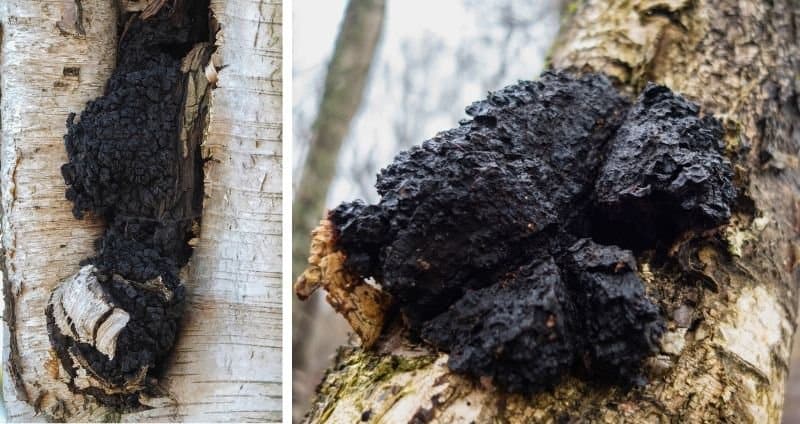
A variety of cultures has touted chaga mushrooms for their potential health benefits to the human body. Outside of Russia, folk and traditional medicine practitioners in Indigenous cultures, Poland, the Baltics, Finland, China, Korea, and Japan have used chaga extracts to:
The Woodland Cree of Canada call the fungus Wesakechak omikih — i.e. Wesakechak’s scab. According to a Cree legend, Wesakechak is a mythological figure who “threw a scab, which he had mistaken for dried meat and tried to eat, against a birch tree. To this day, it remains on the tree to benefit mankind.” Outside of functional uses, the Cree use chaga in agriculture and animal breeding, as incense, and as tinder for starting fires [1].
For information about the modern uses of chaga and the research supporting its health benefits, read our article, Chaga Mushroom Benefits: A Science, Health, & Supplement Guide.
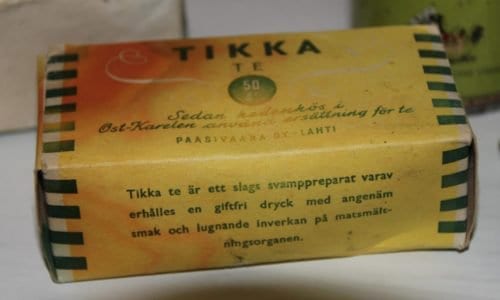
Chaga tea has traditionally been consumed as tea in Finland, Russia, and other countries. Raw chaga chunks can be soaked in hot water, which acts as an extraction agent for all the nutrients from the chitinous interior of chaga.
The most accessible way to make chaga tea is by using a high-quality pure chaga extract like the Real Mushrooms Chaga Extract powder. The hot water extraction method used for our chaga products ensures a higher concentration of the beneficial bioactive compounds than the traditional method. It is also more economical — the amount of chaga powder needed to make the tea is much smaller than using actual chaga chunks.
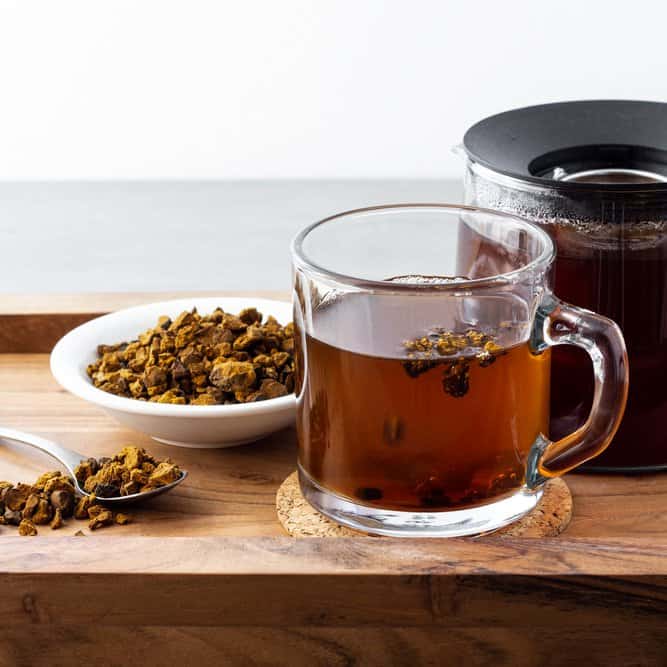
If you live in a Northern part of the world where chaga grows naturally, you have the opportunity to harvest this fungi to make homemade chaga tea.
Chaga preparation: Break up some of the chaga into chunks with a hammer so you have pieces that are approximately 1 inch by 1 inch in size. You will get more out of your chaga the smaller and finer the pieces you can break it down into.
Water temperature: Simmer your water to between 140 F and 160 F, which is under boiling temperature. Boiling water can destroy the antioxidants in chaga, so should be avoided.
Water to chaga ratio: Use approximately 1 cup of water for every 1 inch x 1 inch chunk of chaga.
Steeping: Add the chaga to your water in a pot and bring it to a simmer. Simmer for a minimum of 15 minutes, and up to 1 hour. The longer you brew your tea, the stronger it will be. You can re-use your chaga chunks at least one more time for another tea brewing session.
Chaga tea taste is somewhat earthy with a slight bitterness. To enhance taste, you can add maple syrup, honey, milk, cinnamon, or other ingredients to suit your preferences. Drink chaga and get potential health benefits from its powerful antioxidants.
Chaga tinctures are made by soaking chaga in alcohol — essentially, they are chaga-infused alcohol. Tinctures are a great way to make extracts at home but are not a replacement for a high-quality extract powder. Tinctures are primarily alcohol while extract powders are pure mushroom.
The process of making chaga tinctures is long and takes equipment that may not be readily available. Also, as alcohol can enter the bloodstream very quickly, children and some adults may not tolerate it even at small doses.
We recommend that individuals taking medications seek the advice of a medical professional before consuming alcohol-based tinctures.
Feeling creative in the kitchen and looking for other ways to get your chaga mushroom benefits? Try some of the delicious recipes that customers and health practitioners have created using Real Mushrooms Organic Siberian Chaga Extract Powder or Capsules:
Dalgona Mushroom Coffee (Vegan/Paleo-friendly!
Tahini Adaptogen Latte with Chaga
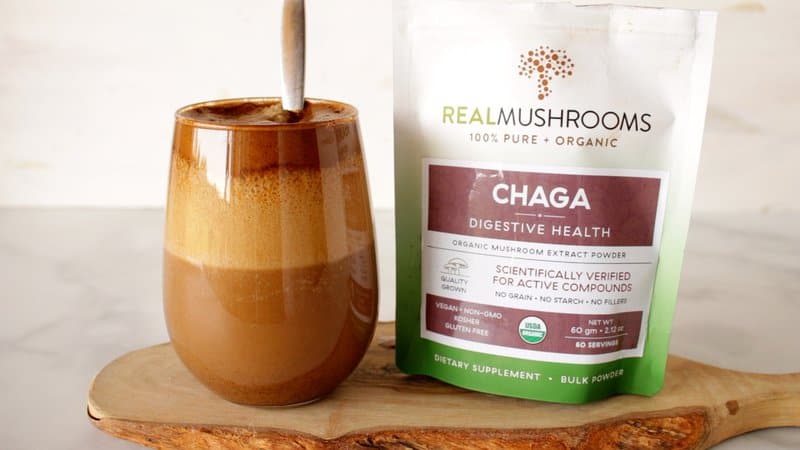
Acai Bowl Recipe with Immune-Supporting Mushrooms
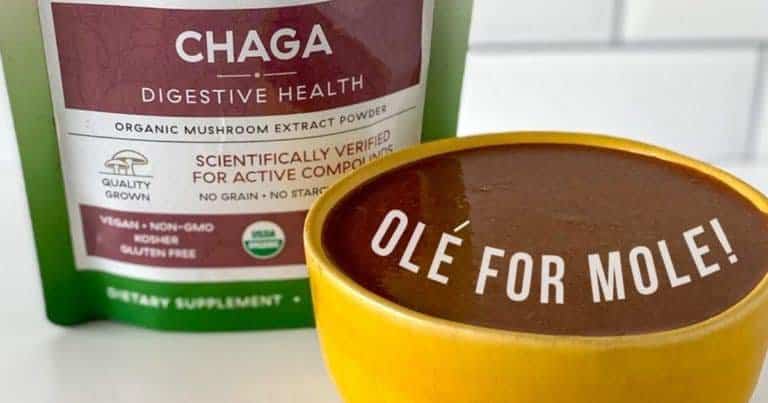
Chaga Cacao Mocha Lava Smoothie Bowl
Chili-Out Chaga Chocolate Bark
Chocolate Dream Chaga Brownies
To begin experiencing the potent health benefits that chaga can bring to your life, try one of our recipes and let us know in our Facebook Group or tag us on Instagram if you find yourself falling in love with this special functional fungi!
*Disclaimer: The statements made in this article have not been evaluated by the Food and Drug Administration. Any products mentioned are not intended to diagnose, treat, cure, or prevent any disease. The information in this article is intended for educational purposes. The information is not intended to replace medical advice offered by licensed medical physicians. Please consult your doctor or health practitioner for any medical advice.

Disclaimer: The information or products mentioned in this article are provided as information resources only, and are not to be used or relied on to diagnose, treat, cure, or prevent any disease. This information does not create any patient-doctor relationship, and should not be used as a substitute for professional diagnosis and treatment. The information is intended for health care professionals only. The statements made in this article have not been evaluated by the Food and Drug Administration. Any products mentioned are not intended to diagnose, treat, cure, or prevent any disease. The information in this article is intended for educational purposes. The information is not intended to replace medical advice offered by licensed medical physicians. Please consult your doctor or health practitioner for any medical advice.
